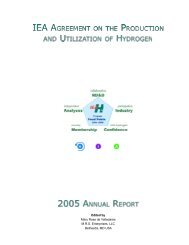Technology Status of Hydrogen Road Vehicles
Technology Status of Hydrogen Road Vehicles
Technology Status of Hydrogen Road Vehicles
You also want an ePaper? Increase the reach of your titles
YUMPU automatically turns print PDFs into web optimized ePapers that Google loves.
alliance with Ballard. The 20-kg/kW FC without buffer energy storage allows only modest acceleration, but<br />
improved FC will decrease this to 4-5 kg/kW in the future.<br />
The customer requirements for drive systems are discussed, and mention is made <strong>of</strong> apparently trivial<br />
problems such as keeping the polymer membrane moist over the temperature range <strong>of</strong> -30º to +60ºC.<br />
Finally Daimler-Benz estimates <strong>of</strong> cost trends for PEM FCs are presented as functions <strong>of</strong> innovation and<br />
production scale. From about the year 2000, a steep rise in quantity and somewhat less steep drop in cost per<br />
kW is expected over about 5 years, dropping <strong>of</strong>f thereafter. The present cost <strong>of</strong> 80-100,000 DM/kW for<br />
demonstration units should drop to 600-700 DM/kW by 2010.<br />
Studies commissioned by GM and Siemens conclude that FC drives can be manufactured in high unit numbers<br />
for 100-110 or 300-500 DM/kW, figures Daimler-Benz still finds very optimistic.<br />
In conclusion, the fuel infrastructure costs and production engineering are regarded as critically important to<br />
the FC future, whereas the core technical problems <strong>of</strong> the FC unit and peripherals can probably be solved with<br />
relatively little difficulty.<br />
Bevers, D., et al., “Innovative Production Procedure for Low Cost PEFC electrodes and membrane<br />
structures,” DLR, Stuttgart, Germany, pp. 1767-1776.<br />
A need is identified for mass production <strong>of</strong> reproducible PEM FC electrodes by a rolling technique well known<br />
for alkaline battery electrodes.<br />
This rolling process was developed with the required potential, and future improvement steps are outlined.<br />
TOPIC 5: Materials and Safety<br />
Linney, R.E.; J.G. Hansel, “Safety Considerations in the Design <strong>of</strong> <strong>Hydrogen</strong>-Powered <strong>Vehicles</strong>,” Air<br />
Products and Chemicals, Pennsylvania, USA, pp. 2159-2168.<br />
Pointing out that on-board hydrogen will bring the public closer to it than any prior application, that the public<br />
is risk-intolerant, and that there are no generally accepted design regulations that cover all aspects <strong>of</strong> such use,<br />
this paper examines:<br />
! Design considerations focusing on safety<br />
! Flammable mixtures surrounding leaks<br />
! Venting hydrogen from vehicles.<br />
And some real-life situations that could arise.<br />
Quantified risk assessment with the fault tree technique could then lead to an evaluation <strong>of</strong> the risk to vehicle<br />
occupants and nearby public.<br />
One important result from this paper is that in many real leak scenarios, high release velocities <strong>of</strong> the H 2 and<br />
normal ambient winds overshadow the buoyancy/diffusivity advantages, so that 5,000 psig H 2 leak can reach<br />
further horizontally than 3,000 psig CH 4.<br />
Pehr, K., “Experimental Examinations on the Worst Case Behavior <strong>of</strong> LH 2/LNG Tanks for Passenger<br />
Cars,” BMW, Munich, Germany, pp. 2169-2186.<br />
67













